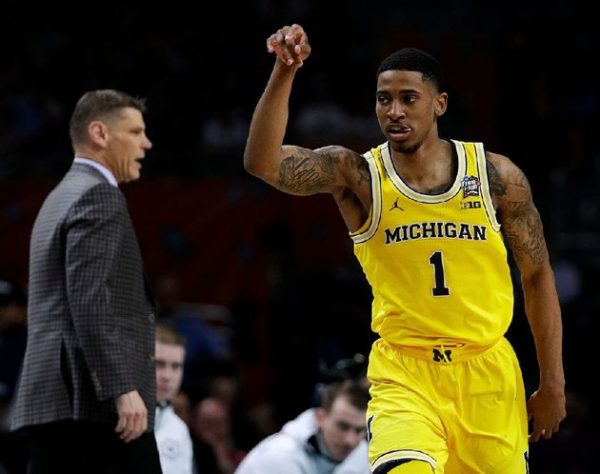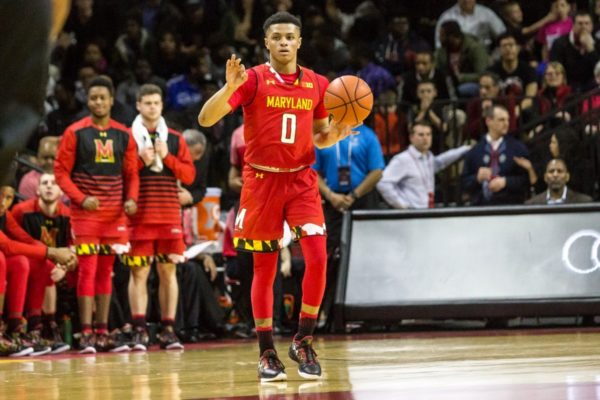Big Ten Wrap-Up: Lasting Impressions and an Early Top Five
Posted by Tommy Lemoine on April 6th, 2018Has Donte DiVincenzo stop hitting shots yet? Okay, good. Now that Monday is behind us, let’s take a moment to reflect on the season that was and look ahead to 2018-19.

Michigan had another year to remember. (PHOTO BY AP/DAVID J. PHILLIP)
- Michigan is an elite basketball program. Before John Beilein took over in Ann Arbor in 2007, Michigan hadn’t reached the NCAA Tournament since 1998, a nine-year drought that made the historically great football school seem like just that — a football school. But that’s changed. Since the drought ended in 2009, Beilein has led the Wolverines to eight NCAA Tournaments, including finishes in the Sweet Sixteen (2017), Elite Eight (2016), and twice in the National Championship game (2013, 2018). After years of mediocrity, Michigan basketball now represents offensive efficiency, outstanding player development and clutch play in March. This season, Beilein — always considered an offensive mastermind — took an unproven collection of talent and won big with his defense, suggesting that the 65-year old coach is still evolving both as a tactician (he recently moved away from the 1-3-1 zone) and manager: His hiring of Illinois State assistant Luke Yaklich as “defensive coordinator” was crucial to the Wolverines’ run. With a decade of excellence under its belt and plenty of talent returning next season, Michigan has firmly established itself among the Big Ten’s elite programs.
- This season will forever sting for Michigan State and Purdue fans. Michigan State went 30-5 and won the outright regular season Big Ten championship. Purdue finished at 30-7, at one point winning 19 straight games. And yet, this season will probably leave a bad taste in both programs’ mouths for some time. For the Spartans, 2017-18 was a Final-Four-or-bust kind of year, with the return of Miles Bridges alongside future NBA lottery pick Jaren Jackson ostensibly giving Tom Izzo his best chance at a National Championship from a talent perspective since 2000. Instead, a season of offensive inconsistency led to an offensively-inept loss to Syracuse in the Round of 32. For the Boilermakers, bad luck prevailed when 7’2″ center Isaac Haas fractured his elbow in the First Round against Cal State Fullerton, his absence proving too much for Purdue to overcome against Texas Tech in the Sweet Sixteen. On paper, both seasons appear successful. In actuality, postseason disappointment will likely overshadow their 60 combined wins.

Ohio State wound up with the Player and Coach of the Year. Who saw that coming? (Kamil Krzaczynski | USA TODAY Sports)
- The middle-to-bottom of the Big Ten was bad, and it hurt the league dearly. Northwestern, Minnesota and Wisconsin all severely underperformed this season, and the league as a whole failed miserably during non-conference play — including an all-time worst 3-11 record in the ACC/Big Ten Challenge. For teams like Nebraska and Penn State, which looked NCAA Tournament-worthy but lacked great resumes, that proved lethal. As Selection Sunday approached, neither bubble-dweller had enough opportunities to notch resume-boostering wins, leaving the margin for error incredibly slim during February. The weak league profile also affected those teams at the top: Despite its 30-4 record and Big Ten regular season title, Michigan State received a #3 seed in the Big Dance. Believe it or not, results matter in November and December.
- Mixed bag for the newbies. For the three new coaches pacing the sidelines in 2017-18, the results were mixed — and in many way surprising. Chris Holtmann took an Ohio State program picked to finish 11th and nearly won the Big Ten title, earning the Buckeyes a #5 seed in the NCAA Tournament and Coach of the Year honors as a result. Archie Miller’s Indiana team lost to Indiana State and IPFW before Christmas, only to turn things around on defense and finish .500 in the league play — a solid, if not spectacular, debut. For Brad Underwood at Illinois, bad on-court luck during the season turned to bad off-court luck after the season: Following a 14-18 finish, top scorer Leron Black went pro while Michael Finke (9.8 PPG), Mark Smith (5.8 PPG), and Te’Jon Lucas (5.7 PPG) all opted to transfer. It will be interesting to see what 2018-19 has in store for all three sophomore coaches.
2018-19 Early Top Five
Recent changes to the NBA Draft early entry rules have been a boon for underclassmen hoping to evaluate their stock without fully committing. The only drawback? It makes early college basketball projections like this one very difficult. Nonetheless, let’s take a look at the league’s best heading into 2018-19 based on the most probable early entry scenarios.

Expect Maryland to return to form in 2018-19. (Marquise McKine/The Diamondback)
- Michigan State. Despite Miles Bridges and Jaren Jackson taking off for the NBA (lottery), Tom Izzo returns a very strong core. Third team all-conference point guard Cassius Winston will be back along with Joshua Langford (11.7 PPG), Matt McQuaid, and five 4-star freshmen, the Big Ten’s best recruiting class. The key question is whether power forward Nick Ward — the best offensive rebounder in college basketball — returns after evaluating his NBA Draft stock. Assuming he does, Michigan State will compete for another conference crown.
- Michigan. Could leading scorers Moritz Wagner and Charles Matthews both make the NBA jump? Sure, but considering that neither is projected as a guaranteed first-rounder, it seems unlikely. Assuming one of the pair returns, Beilein will have a Big Ten Player of the Year candidate to mix with vastly improved point guard Zavier Simpson and promising sophomores Jordan Poole and Isaiah Livers. Throw in a strong recruiting class — including three 4-star incomers — and there’s no question Michigan will finish near the top of the league standings. If both Wagner and Matthews return, the Wolverines are the likely favorite.
- Maryland. The loss of Justin Jackson in December derailed Maryland’s season, and now it will lose the lengthy forward for good to the NBA. Guard Dion Wiley (5.8 PPG) is also gone after deciding to transfer. Luckily, the return of point guard Anthony Cowan (15.8 PPG, 5.1 APG), forward Kevin Huerter (14.8 PPG), and big man Bruno Fernando (10.3 PPG, 6.5 RPG) — who could still leave for the NBA — should help the Terrapins return to the top of the standings. Oh yeah, and Mark Turgeon reeled in 5-star power forward Jalen Smith, the Big Ten’s top recruit to date.
- Nebraska. The Huskers whooped Michigan by 20 points this season, which should tell you everything you need to know about this team’s talent. Although forwards James Palmer Jr. (17.2 PPG) and Isaac Copeland (12.9 PPG) are both testing the NBA draft process, neither signed an agent and it’s reasonable to presume at least one will return to Lincoln. That’s scary, though, considering nearly everyone else is back — including point guard Glynn Watson Jr. (10.5 PPG) and forward Isaiah Roby, who nearly averaged a double-double over his last eight games of the season. In what could be another make-or-break year for Tim Miles, look for Nebraska to go dancing.
- Penn State. The Nittany Lions may well have been the Big Ten favorite if point guard Tony Carr hadn’t declared for the NBA Draft. Still, Penn State welcomes back three double-digit scorers, including NIT MVP Lamar Stevens (15.5 PPG) and center Mike Watkins (12.1 PPG, 8.9 RPG), arguably the league’s premier defensive big man. In winning the NIT title, Pat Chambers’ team finished the season ranked 19th overall by KenPom with a defense also ranked inside the top 20. The return of Big Ten all-defensive team honoree Josh Reaves (10.6 PPG, 2.2 SPG) should help Penn State remain stout.









































